Submitted by maki on 18 December, 2008 - 22:42
This handbook leads to articles about Japanese food and cooking terminology. I think that it may be even more necessary now that Japanese food has become popular outside of Japan.
Filed under:
japanese ingredients terminology
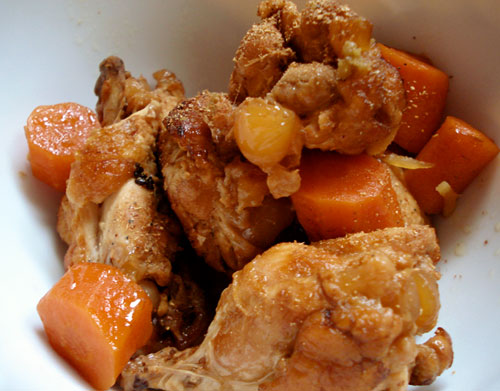
This is another everyday go-to dish around here. Chicken wings are not nearly as cheap as I remember them being during my frugal student days, due to the popularity of things like Buffalo wings. They're still a pretty good deal though. While we love crispy oven-fried wings and such, these deeply flavored braised wings are a great leave-to-cook favorite, especially when the weather gets cold.
This is a dish that is very easy to throw together.
Filed under:
japanese winter chicken favorites slowcook
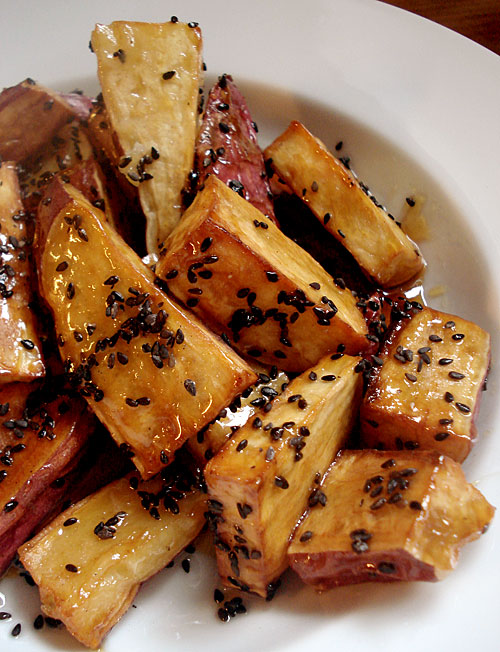
In the fall, many universities throughout Japan have big festivals called 大学祭 daigaku-sai, meaning university festival, or 文化祭 bunnkasai, Culture Festival. They are basically street fairs held on campus, with lots of food and fun stalls, concerts, even ghost houses and amusement rides. Many of the big ones also hold concerts in which top Japanese singers and bands appear. Daigaku Imo, which means University Potato, are candies sweet potatoes, a sweet and slightly savory snack that is often served at university festivals in Tokyo.
The snack itself probably originated as a cheap, calorie-rich, affordable snack sold to cash-poor students around universities in Tokyo around the turn of the 20th century. The idea for deep frying and then sugar coating potatoes most likely came from similar snacks in Chinese cuisine.
Daigaku imo is simple to make, yet a bit tricky. You ideally want to coat the sweet potato slices completely with a hard caramel sugar coating, but too often the sugar gets crystallized. It doesn't taste bad when it does, but it looks far better with a shiny, smooth coating. I've found the best way to accomplish this is to make a fresh batch of the sugar coating for each batch of potatoes cooked. This is not diet food by any means, but regardless, to me they are one of the main treats of fall.
Filed under:
dessert japanese fall vegan gluten-free party snack
Today, three ocean conservation groups in the United States - the Blue Ocean Institute, the Environmental Defense Fund, and the Monterey Bay Aquarium - will each be releasing sushi fish selection guides. They all seem to be printed guides that you have to order (small quibbles: Why not a downloadable PDF so people can start using it immediately? Also, why 3 separate guides?) but if you are a sushi afficionado and are concerned about the sustainability of safety of the fish used as sushi neta, you may want to give one of them a look. See the press release here.
Filed under:
essays japanese sushi
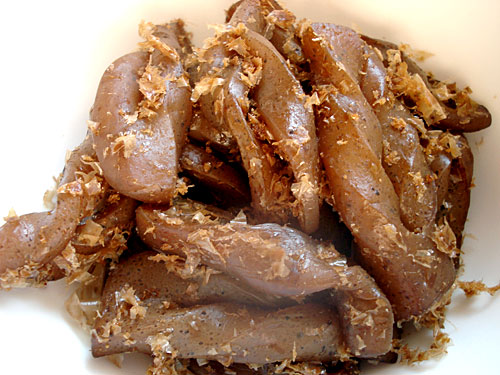
I have talked about konnyaku before, the almost zero calorie, rubbery-jellylike food that makes me really wonder at the ingenuity of people of the past. Why would they think that an almost flavorless, almost nutrient free substance would be edible?
Well, konnyaku is not about its innate flavor - it's all about texture. And since it realy has so little calories, it's a great addition to meals for the dieter, giving a feeling of fullness.
Here are a couple of easy and traditionally Japanese side dishes uses konnyaku. Konnyaku no tosani is konnyaku that is cooked in a flavorful liquid and tossed with plenty of katsuobushi (bonito flakes). __Konnyaku kinpira_ is konnyaku sautéed with sesame and chili pepper.
I tend to make konnyaku dishes when I want to really watch the calories, but still have a hearty appetite.
Filed under:
japanese lighter washoku vegetables kinpira
In the past few years, the popularity of Japanese food has exploded, with sushi leading the way. You might think that as the owner of a blog that is mainly dedicated to Japanese cooking, I'd be ecstatic about that.
I am happy, sure. It's gratifying to gradually see the cuisine of my birthplace being recognized as something special. But on the other hand, I'm more than a bit skeptical. I wonder if, in a few years, hipster 'foodies' are going to turn their noses up at Japanese cuisine. "That was so naughties" they might be saying sometime in 2015, as they tuck into the latest craze for - I don't know what.
Filed under:
books and media japanese philosophy
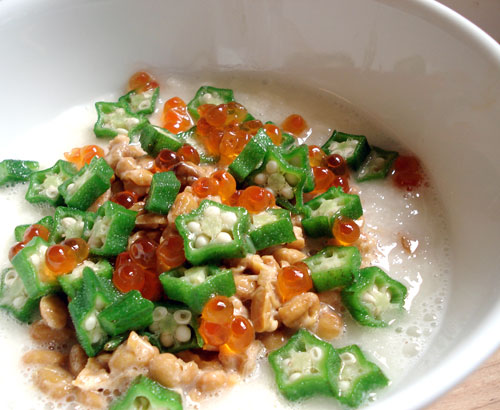
You want slime? I'll give you slime multiplied!
Filed under:
japanese natto offbeat washoku nagaimo slimy
The 100 Japanese foods list is done. Plus, you know, Swiss breast milk.
Filed under:
japanese site news swiss offbeat
[From the archives: Today (September 23rd) is the first day of the fall o-higan (お彼岸), when ohagi or botamochi are offered to ones ancestors, as well as oneself! My mother and my grandmother always made these at home around this time of year - I love their not-too-sweet stickiness. O-higan ends on the 26th, so if you like wagashi, why not give these a try? Originally published March 2007.]
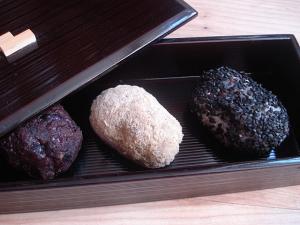 The seven days centered around the bi-annual days of the vernal equinox is a Buddhist festival period known as higan (or o-higan for the honorific term) in Japan. The fall (autumn) higan is aki no higan, and the spring higan is haru no higan. Since the day of the spring equinox is March 21, we're about to enter the haru no ohigan period.
The seven days centered around the bi-annual days of the vernal equinox is a Buddhist festival period known as higan (or o-higan for the honorific term) in Japan. The fall (autumn) higan is aki no higan, and the spring higan is haru no higan. Since the day of the spring equinox is March 21, we're about to enter the haru no ohigan period.
During haru no higan, a sweet confection called botamochi is eaten. The mochi part means sticky, pounded rice, and the bota part comes from botan, or the tree peony. Botamochi is supposed to ressemble a tree peony flower.
During the autumn equinox (aki no higan or simply (o)higan)) period, a very similar confection called ohagi is eaten. This is supposed to look like a hagi or bush clover flower (Latin: Lespedeza thunbergii). Botamochi and o-hagi look the same to me, even though a hagi flower looks nothing like a tree peony flower, but the good old ancestors were probably a lot more imaginative than I am.
Botamochi and o-hagi are made of sticky rice and sweet tsubuan, 'chunky-style' sweet azuki bean paste. They are a bit fiddly to make but not difficult, especially if you use one of my favorite cooking helpers, plastic cling film. Since these are best eaten freshly made, it's well worth the effort to make them at home if you like bean-based Japanese sweets. You can adjust the amount of sugar in the tsubuan to your taste. Here I have made three variations: coated with black sesame seeds; coated with kinako (toasted soy bean powder); and the most traditional form with the rice cake wrapped in a layer of the tsubuan.
Filed under:
dessert japanese legumes rice vegetarian sweet vegan gluten-free wagashi
Submitted by maki on 11 September, 2008 - 10:52
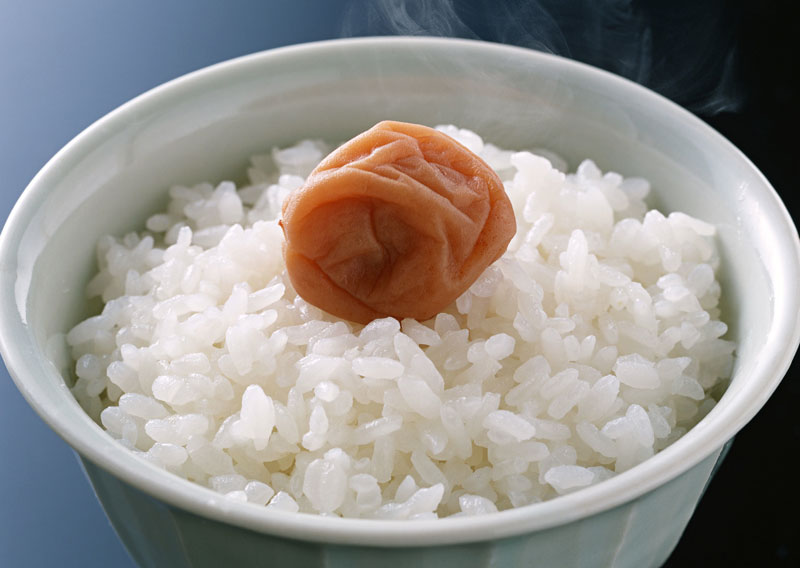
What 100 Japanese foods would I recommend people try at least once?
I tried to keep away from foods that are only available in certain regions, or even certain restaurants or homes (e.g. my aunt's homemade udon) and stuck to foods that are widely available in Japan. I've also tried to include foods from all categories and all price ranges, from wildly expensive matsutake mushrooms to cheap and sometimes not so good for you snacks. I also did not limit the list to 'genuine Japanese' foods (純和風), but include Western-style yohshoku dishes and a sprinkling of chuuka (imported Chinese) foods that are so ingrained in Japanese food culture that most people barely think of them as Chinese any more. And of course, I have eaten all of the foods listed at least once - in most cases many, many times. I like them all!
Type:
feature Filed under:
japanese ingredients offbeat lists
Pages